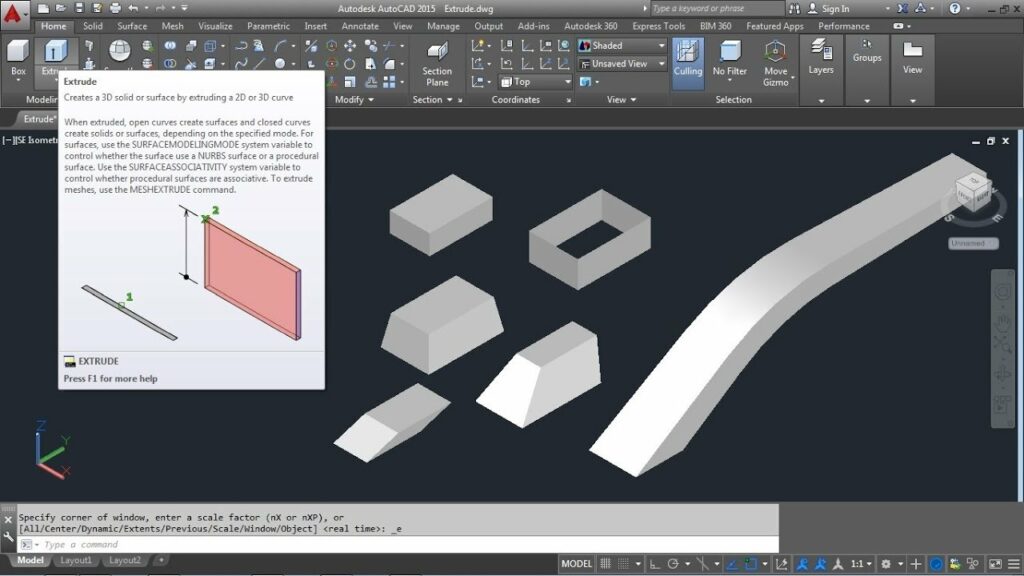Elevating Designs: A Comprehensive Guide on Applying the Extrude Command to Transition from 2D to 3D in AutoCAD

Introduction:
In the dynamic world of Computer-Aided Design (CAD), the ability to seamlessly transition from 2D to 3D is a hallmark of advanced design proficiency. AutoCAD, a leading software in the CAD domain, provides powerful tools for this transition, and among them, the Extrude command is a fundamental feature. This extensive guide aims to unravel the intricacies of applying the Extrude command in AutoCAD, exploring its functionalities, applications, and the profound impact it has on transforming flat 2D entities into dynamic and visually compelling 3D models.
Section 1: Understanding the Extrude Command in AutoCAD
1.1 Defining the Extrude Command: The Extrude command in AutoCAD is a powerful tool that enables users to give depth and dimensionality to 2D objects, essentially transforming them into 3D entities. This command extrudes selected shapes along a specified axis, creating a third dimension and opening up a realm of possibilities for design exploration.
1.2 The Concept of Extrusion: Delve into the concept of extrusion within the context of AutoCAD. Understand how the Extrude command extends the geometry of 2D entities along a defined direction, providing a straightforward yet versatile approach to 3D modeling.
Section 2: Navigating the AutoCAD Interface for Extrusion
2.1 Accessing the Extrude Command: Learn how to access the Extrude command in AutoCAD. Understand the various methods, including menu options, toolbar buttons, and keyboard shortcuts, providing flexibility in incorporating extrusion into your workflow.
2.2 Extrusion Options and Parameters: Explore the extrusion options and parameters available within AutoCAD. Understand how to define the height, taper angle, and other parameters to tailor the extrusion process to the specific requirements of your design.
Section 3: Extruding 2D Objects in AutoCAD
3.1 Selecting 2D Objects: Understand the process of selecting 2D objects for extrusion. Explore the flexibility of the Extrude command in accommodating various shapes, including lines, circles, polygons, and splines.
3.2 Specifying the Extrusion Direction: Learn how to specify the extrusion direction for selected objects. Understand the use of reference points, axis options, and interactive methods for defining the direction of extrusion, ensuring precision in 3D modeling.
Section 4: Advanced Extrusion Techniques
4.1 Tapered Extrusions: Delve into advanced extrusion techniques, such as tapered extrusions. Learn how to create dynamic and visually interesting 3D shapes by applying a taper angle to the extrusion process.
4.2 Pathway Extrusions: Explore the concept of pathway extrusions in AutoCAD. Understand how to extrude objects along a specified path, allowing for the creation of intricate 3D shapes that follow a defined trajectory.
Section 5: Editing and Modifying Extrusions
5.1 Modifying Extrusion Heights: Learn how to edit and modify extrusion heights within AutoCAD. Explore techniques for adjusting the height of extruded objects interactively or by inputting precise numerical values.
5.2 Tapering Adjustments: Understand how to make tapering adjustments to extrusions. Explore methods for altering the taper angle to achieve desired visual effects and meet specific design criteria.
Section 6: Working with Solid and Surface Extrusions
6.1 Creating Solid Extrusions: Explore the creation of solid extrusions in AutoCAD. Understand how the Extrude command can be applied to create 3D solids, providing a volumetric representation of objects with mass and density.
6.2 Surface Extrusions: Delve into the concept of surface extrusions. Learn how to use the Extrude command to create 3D surfaces, which are valuable for representing complex geometries and facilitating smooth transitions between shapes.
Section 7: Extrusion and 3D Modeling Workflows
7.1 Integrating Extrusions in 3D Models: Understand how to integrate extrusions seamlessly into 3D modeling workflows. Explore techniques for combining extruded shapes with other 3D entities, such as meshes, solids, and regions.
7.2 Boolean Operations with Extrusions: Delve into Boolean operations involving extrusions. Learn how to perform union, subtraction, and intersection operations with extruded objects, enabling the creation of complex 3D forms through the combination of simpler shapes.
Section 8: Advanced Techniques and Tips
8.1 Dynamic 3D Text: Explore advanced techniques for creating dynamic 3D text using the Extrude command. Learn how to extrude text entities, adding depth and dimensionality to annotations and labels within your drawings.
8.2 Extruding Custom Shapes: Delve into the process of extruding custom shapes in AutoCAD. Understand how to create complex 2D profiles and extrude them into unique 3D objects, expanding the possibilities for innovative designs.
Section 9: Challenges and Troubleshooting
9.1 Overcoming Common Extrusion Challenges: Address common challenges encountered when working with the Extrude command. From unexpected results to issues with directionality, gain insights into effective problem-solving strategies.
9.2 Troubleshooting Tips: Explore troubleshooting tips for resolving issues related to extrusions in AutoCAD. From misalignments to unintended deformations, understand how to maintain control and precision in your 3D models.
Section 10: Collaboration and Extrusions
10.1 Sharing Extruded Models in Collaborative Workflows: Understand how to share extruded models in collaborative workflows. Explore techniques for collaborating with team members, ensuring consistent extrusion practices, and maintaining design integrity.
10.2 External References (Xrefs) and Extrusions: Explore the integration of external references (Xrefs) with extrusions. Learn how Xrefs can be utilized to enhance collaboration, allowing team members to work on specific sections of a drawing while maintaining the continuity of extruded objects.
Conclusion:
As we conclude this exhaustive exploration of applying the Extrude command to transition from 2D to 3D in AutoCAD, it is evident that this feature is a pivotal tool for elevating designs and expanding the creative possibilities within the CAD environment. Whether you are a novice seeking to enhance your 3D modeling skills or a seasoned professional navigating complex projects, mastering the Extrude command transforms your design approach. Embrace the depth, dimensionality, and versatility that extrusions bring to your AutoCAD workflow, and witness how this fundamental tool elevates your designs from flat representations to dynamic, visually compelling 3D models. With continuous practice, exploration, and innovation, you will navigate the intricate landscape of 3D modeling with confidence, producing designs that stand as testaments to the power of extrusions in AutoCAD.




